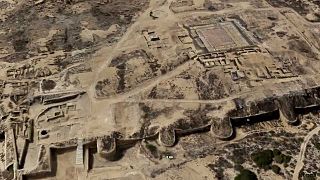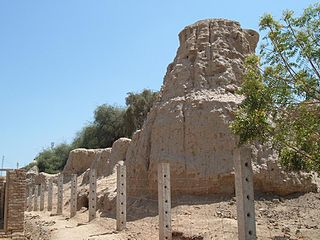
Karachi is the capital of the Pakistani province of Sindh. It is the largest city in Pakistan and seventh largest city proper in the world. Ranked as a beta-global city, the city is Pakistan's premier industrial and financial centre, with an estimated GDP of $114 billion (PPP) as of 2014. Karachi is Pakistan's most cosmopolitan city, its most linguistically, ethnically, and religiously diverse city, as well as one of Pakistan's most secular and socially liberal cities. With its location on the Arabian Sea, Karachi serves as a transport hub, and is home to Pakistan's two largest seaports, the Port of Karachi and Port Bin Qasim, as well as Pakistan's busiest airport, Jinnah International Airport.

The Districts of Pakistan, are the third-order administrative divisions of Pakistan, below provinces and divisions, but forming the first-tier of local government. In total, there are 154 districts in Pakistan including the Capital Territory and the districts of Azad Kashmir and Gilgit Baltistan. These districts are further divided into Tehsils, Union Councils.

Kachhi District or Kacchi, known until 2008 as Bolan, is a district in central Balochistan, Pakistan. The Bolan area remained under one district Kacchi until 31 December 1991. The Deputy Commissioner's office started functioning on 17 May 1992, and Bolan became one of the four districts of Naseerabad Division, until the abolition of Divisions in 2000.

The four provinces and three autonomous territories of Pakistan are subdivided into administrative "divisions", which are further subdivided into districts, tehsils and finally union councils. These divisions were abolished in 2000, but restored in 2008. The divisions do not include the Islamabad Capital Territory or the Federally Administered Tribal Areas, which were counted at the same level as provinces, but in 2018 the Federally Administered Tribal Areas were subsumed into Khyber-Paktunkhwa Province.

The Badin District is a district in the Sindh province of Pakistan. The total area of the district is 6,726 square kilometers. It had a population of 1,136,636, in 1998, of which 16.42% were urban, according to the Pakistani census taken at the time. Total population of District Badin was recorded as 1,804,516 in the census of 2017. Headquartered at the city of Badin, the district is situated between 24°-5` to 25°-25` north latitude and 68 21’ to 69 20’ east longitude and is bounded on the north by the Tando Allahyar District, Northwest by the Hyderabad District, on the east by Mirpurkhas and Tharparkar districts, on the south by the Kutch district of India, and on the west by Sujawal and Tando Muhammad Khan District.

Ghotki District is a district of the province of Sindh, Pakistan, with headquarters the city of Ghotki. Prior to its establishment as a district in 1983, it formed part of Sukkur District. According to the 1998 census, the district had a population of 970,550. Of these residents, 158,500 (16.33%) lived in urban areas, and 812,050 (83.67%) lived in rural areas.

I. I. Chundrigar Road is located in central business district of Karachi, Pakistan, and is named after former Pakistani Prime Minister Ibrahim Ismail Chundrigar. The road serves as the spine of Pakistan's largest financial centre, and is frequently referred to as "Pakistan's Wall Street".

Buddhism in Pakistan took root some 2,300 years ago under the Mauryan king Ashoka. Buddhism has played a major role in the history of Pakistan — the land of which over time has been part of predominantly Buddhist empires such as the Indo-Greek Kingdom, the Kushan Empire, the Maurya Empire of Ashoka, the Pala Empire.

Tourism in Pakistan is a growing industry. In 2010, Lonely Planet termed Pakistan as being "...tourism's ‘next big thing’ for more years than we care to remember. The country is geographically and ethnically diverse, and has a number of historical and cultural heritage sites. The upsurge in tourism in the past few years has been aided by the Government of Pakistan's recent decision to end mandatory No Objection Certificates for foreign tourists seeking to visit certain parts of the country. and opening up

Bhanbhore or Bhambhore, is a city dating to the 1st century BCE located in modern-day Sindh, Pakistan. The city ruins lie on the N-5 National Highway, east of Karachi. It dates back to the Scytho-Parthian era and was later controlled by Muslims from the 8th to the 13th century, after which it was abandoned. Remains of one of the earliest known mosques in the region dating back to 727 AD are still preserved in the city. In 2004, Department of Archaeology and Museums Pakistan submitted the site for UNESCO World Heritage Sites.

Wahi Pandhi is a town near Johi, Dadu District of Sindh, Pakistan. A road from Wahi Pandhi leads to Gorakh Hill. There is an archaeological mound, locally famous as 'Kotero Daro' was explored by N. G. Majumdar during his explorations in Sindh from 1926 to 1929. The pottery of Amri and Harappan phase was explored at the mound.

Archaeological Museum Umerkot or Umerkot Museum is an archaeological museum established in 1968, situated inside the Umerkot Fort which is located in Umerkot District, Sindh Province, Pakistan.

Moomal Ji Mari is an archaeological site in village Mirpur Mathelo, Sukkur District now Ghotki District of Sindh, Pakistan.Many clay toys and artifacts were explored. The remains of wall made from backed and unbaked bricks have been found nearby the explored toys and earthen lamps. It is located on a high mound in Mathelo village at a distance of 8 kilometers from Ghotki city. It is surrounded by a fort or fortress. At present it is spread over an area of 3 acres. It is believed to be house of Moomal. The mound of Moomal Ji Mari is about 15 feet high. The pottery of different kinds was observed on the mound. Whereas, it is believed that Moomal was a daughter of Raja Nand who constructed a palace for her on mound. This palace was constructed around 590 AD during the realm of Rai Sahasi II. in Rai dynasty of Sindh. A cultural complex has been built by culture department government of Sindh. Some historians relate it with love tale of Moomal Rano of Soomra Dynasty of Sindh. Rano was Sodho by caste.

Kaleemullah Lashari is an archaeologist, historian and author. In March 2019, the government of Pakistan awarded him the Sitara-i-Imtiaz, the third highest honour and civilian award in Pakistan. He works to preserve the cultural heritage of ancient Pakistan.

Sindh Tourism Development Corporation (STDC) is an organization of the Government of Sindh, Pakistan. STDC is governed by the Board of directors and provides facilities to the national and international tourists. It runs several motels and resorts across the Sindh province. STDC was incorporated on June 5, 1992.

Abdul Majid Bhurgri Institute of Language Engineering is an autonomous body under the administrative control of the Culture, Tourism and Antiquities Department, Government of Sindh established for bringing Sindhi language at par with national and international languages in all computational process and Natural language processing.

Serai Quarter, sometimes called Serai Quarters, is a neighborhood in central Karachi, Pakistan that forms much of its historic central business district. In addition to Karachi's financial centre centered on Serai Quarter's I. I. Chundrigar Road, Serai Quarter contains over 200 historic buildings, which make up about 37% of all building plots in the quarter. Of these, 78 are protected by the Sindh Cultural Heritage Preservation Act of 1994.

















